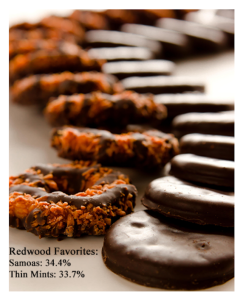Girl Scout cookie season is underway, and whether it’s the cool minty chocolate covered Thin Mints or the sweet caramel and crunchy toasted coconut of a Samoa, the cookies have become an iconic and delicious staple of American culture.
For this year’s sales, the two Girl Scout cookie bakers, ABC Bakers and Little Brownie Bakers, have made some changes to meet customers’ dietary needs.
“This year’s Thin Mint was vegan, and most people didn’t notice the taste change,” said Sarah Jane Zarko, the Girl Scout Cookie Manager for Marin County’s troops.
Along with the Thin Mints, Peanut Butter Patties have also become vegan.
However, the biggest request customers had were for gluten free cookies—and the bakers delivered. The Toffee-tastic, a rich buttery cookie with crunchy toffee bits, and

Trios, a peanut butter cookie with chocolate chips, were both new additions to the Girl Scout cookie lineup for people who do not eat gluten.
As well as being made with dietary restrictions in mind, all the cookies are made without trans fats. Certain varieties such as the Rah-Rah Raisins are also whole grain for people looking for a healthier option.
“It’s always the Thin Mints. You have your top three―the Thin Mints sell the most, Samoas the second most, and Tagalongs come in third,” Zarko said.
34.3 percent of students said that Samoas were their favorite Girl Scout cookie, and 33.7 percent said that Thin Mints were their favorite. After that there was a significant drop off, with 14.1 percent of students reporting that their favorite cookies were Tagalongs. 9.6 percent of students said that they do not eat Girl Scout cookies.
Although they cannot be bought in stores, Girl Scout cookies can be found in a variety of places, including small tables that troops set up to sell in shopping malls, or simply going around their neighborhoods.
“When we were little we would go door-to-door, but this year I just sold most of them at school,” said sophomore Kate Garrison, who has been a Girl Scout for the past eight years.
Forty-six percent of students also reported buying cookies themselves this year, with 15.3 percent buying four or more boxes.






